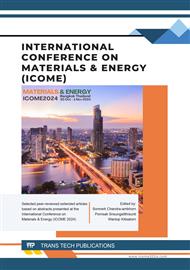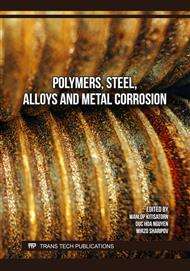[1]
E. Almanza and L. E. Murr, "A Comparison of sensitization kinetics in 304 and 316 stainless steels," Journal of Materials Science, vol. 35, 2000, pp.3181-3188.
Google Scholar
[2]
X. Zhang, J. Tang, H. Liu, J. Gong, "Effects of pre-strain on sensitization and interganular corrosion for 304 stainless steel" Engineering Failure Analysis, vol. 106, 2019, 104179.
DOI: 10.1016/j.engfailanal.2019.104179
Google Scholar
[3]
S. Tokuda, Izumi Muto, Yu Sugawara, Nobuyoshi Hara, "Pit initiation on sensitized Type 304 stainless steel under applied stress: Correlation of stress, Cr-depletion, and inclusion dissolution," Corrosion Science, 167, 2020, 10856.
DOI: 10.1016/j.corsci.2020.108506
Google Scholar
[4]
R. Mohammed, Dilkush, S. R. K, and M. R. G, "Studies on microstructure, mechanical and pitting corrosion behaviour of similar and dissimilar stainless steel gas tungsten arc welds," Materials Science and Engineering, vol. 330, 2018, pp.2-8.
DOI: 10.1088/1757-899x/330/1/012028
Google Scholar
[5]
Q. Wang, B. Zhang, Y. Ren, K. Yang, "A self-healing stainless steel: Role of nitrogen in eliminating detrimental effect of cold working on pitting corrosion resistance," Corrosion Science, vol. 145, 2018, pp.55-66.
DOI: 10.1016/j.corsci.2018.09.013
Google Scholar
[6]
P. R. Kannan, V. Muthupandi, K. Devakumaran, C. Sridivya, E. Arthi, "Effect of grain size on self -healing behaviour of sensitized S304HCu stainless steel," Materials Chemistry and Physics, vol.207, 2018, pp.203-211.
DOI: 10.1016/j.matchemphys.2017.12.012
Google Scholar
[7]
B. Sun, Z. Liu, Y. He, F. Cao, X. Li, "A new study for healing pitting defects of 316L stainless steel based on microarc technology," Corrosion Science, vol. 187, 2021, 109505.
DOI: 10.1016/j.corsci.2021.109505
Google Scholar
[8]
S. Wei, L. Zhao, S. Lu, "Influencing mechanisms of C content and aging treatment on intergranular corrosion sensitivity of 316 stainless steel weld metals," Journal of Materials Research and Technology, vol. 31, 2024, pp.73-82.
DOI: 10.1016/j.jmrt.2024.06.032
Google Scholar
[9]
H. Granados-Becerra, V.H. López-Morelos, A. Ruiz, T. del N.J. Sánchez-Cruz, F.F. Curiel-López, J.A. Gonzalez-Sanchez, "Influence of ageing treatment time on microstructural evolution, sensitization and self-healing of Inconel 600," Journal of Alloys and Compounds, vol. 994, 2024, 174655.
DOI: 10.1016/j.jallcom.2024.174655
Google Scholar
[10]
S. Esmailzadeh, M. Aliofkhazraei, H. Sarlak, "Interpretation of Cyclic Potentiodynamic Polarization Test Results for Study of Corrosion Behavior of Metals: A Review," Protection of Metals and Physical Chemistry of Surface, vol. 34, 2018, pp.976-989.
DOI: 10.1134/s207020511805026x
Google Scholar
[11]
P D Tiedra, O Martín, C García, F Martín, M López, "Effect of prior cold work on the degree of sensitization of welded joints of AISI 316L austenitic stainless steel studied by using an electrochemical minicell," Corrosion Science, vol.54, 2012, pp.153-160.
DOI: 10.1016/j.corsci.2011.09.010
Google Scholar
[12]
J. Gong, Y. M. Jiang, B. Deng, J. L. Xu, J. P. Hu, J. Li, "Evaluation of intergranular corrosion susceptibility of UNS S31803 duplex stainless steel with an optimized double loop electrochemical potentiokinetic reactivation method," Electrochimica Acta vol. 55:18, 2010, pp.5077-5083.
DOI: 10.1016/j.electacta.2010.03.086
Google Scholar
[13]
T. Amadou, C. Braham, and H. Sidhom, "Double Loop Electrochemical Potentiokinetic Reactivation Test Optimization in Checking of Duplex Stainless Steel Intergranular Corrosion Susceotibility," Metallurgical and Materials Transaction A, vol. 35, 2004, pp.3499-3513.
DOI: 10.1007/s11661-004-0187-4
Google Scholar
[14]
S. Frangini and A Mignone, "Modified electrochemical potentiokinetic reactivation method for detecting sensitization in 12 wt% Cr ferritic stainless steels," CORROSION, vol. 48:9, 1992, pp.715-726.
DOI: 10.5006/1.3315992
Google Scholar
[15]
Xk Lian, Y. Li, Y. Xiong, et al. "Effect of annealing time on microstructure and mechanical properties of cryorolled AISI 310S stainless steel," Journal of Iron and Steel Research International, vol. 30, 2023, p.548–556.
DOI: 10.1007/s42243-022-00870-9
Google Scholar



